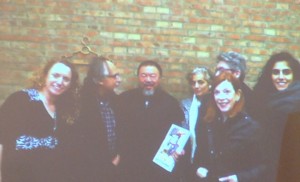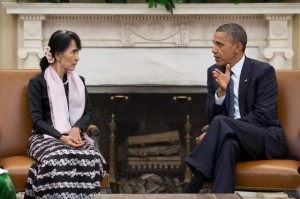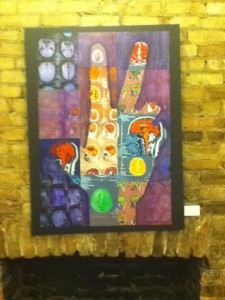Update: Late Monday this photo by the Washington Post’s David Nakamura of an embrace between Aun Sang Suu Kyi and Hillary Clinton, with President Obama looking on, hit the newswires. Happy to add it to this post.

—
Some human rights activists are criticizing President Obama for making Burma a stop on his current visit to Southeast Asia. They say the country still holds captive many political prisoners, and that it’s too soon to favor them with a presidential visit. I share their concern that the gains made over the past year aren’t sufficient, and that reversals in the process may still occur. And yet, I believe that the visit, which brings with it not just the president but Hillary Clinton and the whole force of the State Department is the best way to ensure progress and forestall a return to the repression of the past decades.
The NY Times reports that while sharing a dais with Aung San Suu Kyi President Obama said of Burma today:
“‘You must reach for the future you deserve, a future where a single prisoner of conscience is one too many. You need to reach for a future where the law is stronger than any single leader.’”
The Times adds that “Although human rights activists criticized him for visiting while hundreds of political prisoners remain locked up and violence rages through parts of the country, Mr. Obama used the occasion to nudge Myanmar to move further.” The president was greeted on arrival “by further promises of reform by the government, which announced a series of specific commitments regarding the release of political prisoners and the end of ethnic violence. Although Mr. Obama stayed just six hours, his visit was seen here as a validation of a new era. . . . John Sifton of Human Rights Watch said that if the promises [Prime Minister] Mr. Thein Sein announced Monday were kept, it would ‘be a huge step in the right direction for the people’ and future of Myanmar, although he maintained it could have been achieved without rewarding the government with a presidential visit so soon.”
Readers of this blog may recall that last winter I attended the opening of an exhibit put on by The Mantle: a forum of progressive critique at Gallery 35 of Burmese artists whose work spanned the period before the loosening and after it had begun. The latter pieces reflected an early, wary response to the government’s new openness, and blogged about it at the time. The art was really compelling too, not just as political messages. I’ve posted some of the images here–there are lots more at the original post.

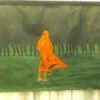
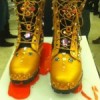
In September, when Aung San Suu Kyi visited Washington, I shared two great pictures from her visit, like the one below taken with Hillary. I’m glad America is engaged this way, not just with Burma, but also reaching out to Thailand and Cambodia on this presidential trip, and look forward to seeing more diplomacy like over the next four years. Though China’s dominance in the region is undeniable, American influence with these smaller countries with growing economic dynamism, is going to be very important, for American trade and public approval.


